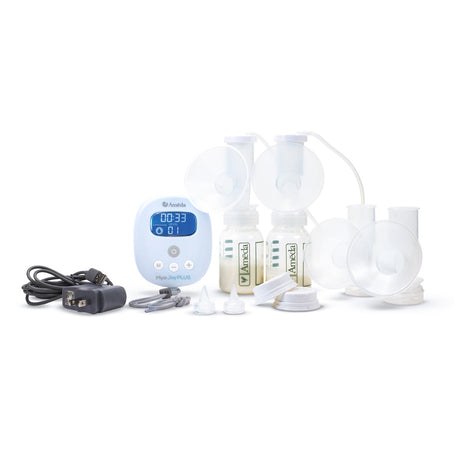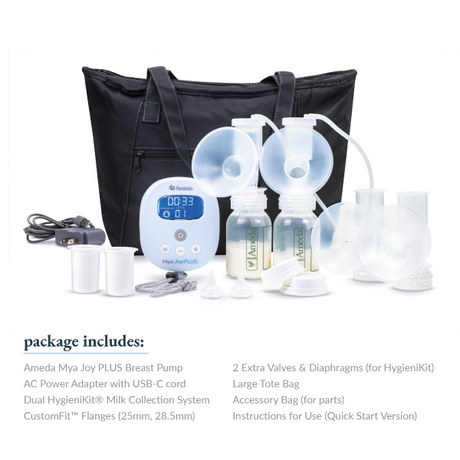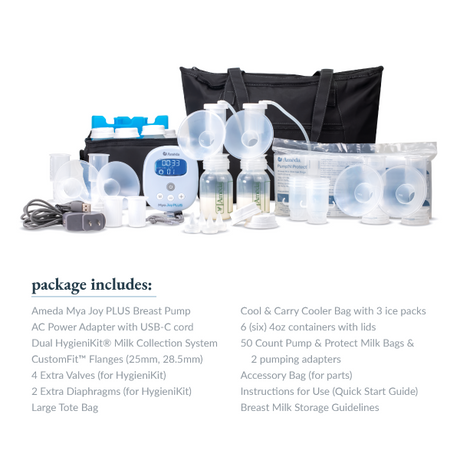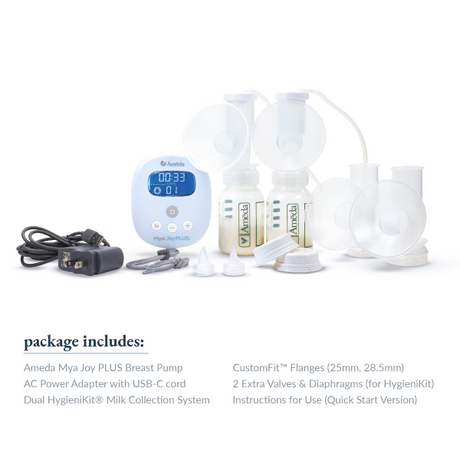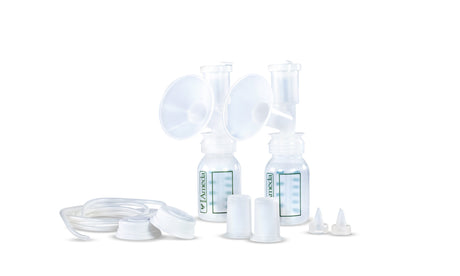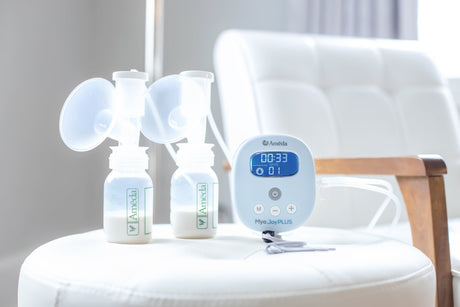Published:
Just like anything new, breastfeeding takes practice. But it won’t be long before it feels like second nature to you. In the meantime, here are some breastfeeding techniques for positioning your baby and helping her to latch on and start breastfeeding. Topics covered here:
- Getting ready to feed
- Achieving a good breastfeeding hold
- Achieving a good latch
GETTING READY TO BREASTFEED
Did you know that babies are born with feeding reflexes that can help them get to the breast and latch on their own? In fact, when mothers and babies are kept skin to skin in the first hour or two after birth, most healthy babies demonstrate these instinctive behaviors by slowly pushing their way up to the breast, opening their mouths, dropping their tongues and latching on their own or with just a little guidance. Here are some ways you can prepare before you breastfeed your baby.
1. Build up your breastfeeding support community
In many cultures, women grow up watching other women breastfeed. So, a new mom has this experience and an already built-in support system. If you haven’t had this experience, like most of us, attend a breastfeeding class and find a local breastfeeding support group in your area to help prepare yourself. In addition, you could watch our educational breastfeeding video here.
2. Observe and begin to learn your baby’s feeding instincts and hunger cues
- Right after your baby is born, let her lie skin to skin on your chest until she breastfeeds for the first time.
- Learn to identify your baby’s early hunger cues as it is best to start breastfeeding with a calm, quiet, and alert baby. Some early hunger cues include:
- Rooting (moving her head side to side with an open mouth when her cheek is touched);
- Sticking her tongue out;
- Sucking on her hands.
- If your baby is crying, don’t force her to breastfeed. First, soothe your baby by holding, swaying, walking, or rocking her.
3. Help your breasts make milk
- Breastfeed or pump within one hour of baby’s birth.
- Breastfeed or pump 8-10 times every 24 hours, about every 3 hours.
- Massage and gently squeeze your breasts before and during breastfeeding or pumping.
- If pumping, hand express afterwards for a few minutes to help drain your breasts of milk.
4. Have some pillows, towels, and maybe a supportive chair on hand for you and your baby’s comfort during feeding
- If you are lying down to breastfeed, you may use a towel or blanket to support your baby’s back.
- If you are sitting upright to breastfeed, you may place pillows behind your back (do not just think horizontally, vertically is also great) and under your arms to help you relax and be comfortable while you breastfeed. Have a rolled-up towel or baby blanket within your reach. Place the baby on top of the pillow at your side or in front of you (depending on which position you use) so that the baby is at breast level.
- If you are sitting upright to breastfeed, find a seat with good back support. Also try a footstool for additional support.
ACHIEVING A COMFORTABLE BREASTFEEDING POSITION
It may take some time to figure out the most comfortable, effective breastfeeding position for you and your baby. What might work for one mom and baby may not work well for another. Do what feels good for both of you and whenever you can, breastfeed skin to skin. Here are some commonly used breastfeeding positions you can try.
Commonly Used Breastfeeding Positions
- Breastfeeding Lying Down
- Laid-back or reclining position
- Side-lying position
- Breastfeeding Upright
- Football position
- Cross-cradle
- Cradle
In all breastfeeding positions, check for the following:
- Your baby’s head, shoulders, and hips are in line, not twisted or turned.
- She is directly facing the breast, no head-turning needed.
- Her body is pressed against yours, with feet, bottom, and shoulders pulled in close (no gaps).
- Her head is free to tilt back a bit, and she comes to the breast chin first.
BREASTFEEDING LYING DOWN POSITIONS

Laid-Back or Reclining Position
Recommended for: starting to breastfeed
- Lean back with good neck, shoulder, arm and back support and your hips forward, like how you sit in a recliner chair.
- Place your baby’s belly on your belly with her head between your exposed breasts. When your hungry baby feels your body against her chin, torso, legs, and feet, this triggers her feeding reflexes. When her chin touches your body, her mouth opens and she begins to search for the breast. Adjust her body position as needed, making sure she can breathe.
- Babies can go to the breast from many angles. Your baby can lie belly down below your breast either straight or at an angle. After a cesarean birth, try other angles, so that your baby doesn’t rest on your healing incision.

Side-Lying Position
Recommended for: when mom wants rest or due to pain from delivery.
- Lie on your side facing your baby with one pillow under your head and one behind your back. Have a rolled-up towel or baby blanket within your reach.
- Put your baby on her side, facing you, with your nipple in line with her nose.
- Pull her feet and bottom in close. Lean back onto the pillow behind you until your nipple lifts off the bed to the level of your baby’s mouth.
- When your baby opens her mouth wide, she will quickly move towards the breast. At the same time gently press the palm of your hand between her shoulder blades to help her latch on deeply.
- Wedge the towel or blanket behind her back, leaving her head free to tilt back.
- Some mothers like their baby’s head resting on their arm. Others prefer their baby’s head on the bed.
BREASTFEEDING UPRIGHT POSITIONS

Football Position
Recommended for: nursing twins, C-section
- Place a pillow at your side on the side you are going to breastfeed from. WIth your arm around your baby, lie your arm on top of the pillow, angling the baby towards you. Her face should be near your breast with her feet back towards your back.
- The arm, on the same side as the breast you are going to feed her from, should be behind your baby supporting her. For example, your right arm if you are breastfeeding her from the right breast.
- Make a c-shape with your hand by spreading your thumb and forefinger apart. Support your baby’s neck/head in the web of your hand (between your thumb and forefinger) so that her head is tilted back a little. Her chin should never be touching her chest (this places her tongue and jaw in the wrong position for a good latch).
- Bring your baby in close to you.
- With the opposite hand, make a c-shape and gently support your breast, compressing it slightly, like you would if you were holding a sandwich. Make sure your fingers are parallel (in the same direction) to your baby’s lips. Keep your fingers off of the areola. This will help your baby get a deep latch.
- Position your nipple between your baby’s upper lip and nose, this triggers your baby’s rooting reflex. As your baby opens wide, use the palm of your hand to gently push between her shoulder blades and bring her in close. This movement will help her head to tilt back in the proper position to latch with her chin towards the breast and her nose slightly away from the breast.
- You may find it helpful to place a rolled-up towel or baby blanket under your wrist (holding the baby) for additional support.

Cross-Cradle Position
Recommended for: Helping guide the baby’s head to the breast for a deep latch, helps transition to the more advanced cradle hold.
- Place a pillow in your lap and lie your baby sideways facing you, with your arm around the baby. Her ear, shoulders and hip should be touching the pillow, in a line.
- The arm, opposite from the side you are going to breastfeed on, should be behind the baby. For example, your left arm if you are breastfeeding her from the right breast.
- Make a c-shape with your hand by spreading your thumb and forefinger apart. Support your baby’s neck/head in the web of your hand (between your thumb and forefinger) so that her head is tilted back a little. Her chin should never be touching her chest (this places her tongue and jaw in the wrong position for a good latch).
- Bring your baby in close to you.
- With the opposite hand, make a c-shape and gently support your breast, compressing it slightly, like you would if you were holding a sandwich. Make sure your fingers are in the same direction as your baby’s lips. Keep your fingers off of the areola. This will help your baby get a deep latch.
- Position your nipple between your baby’s upper lip and nose, this triggers your baby’s rooting reflex. As your baby opens wide, use the palm of your hand to gently push between her shoulder blades and bring her in close. This movement will help her head to tilt back in the proper position to latch with her chin towards the breast and her nose slightly away from the breast.

Cradle Position
Recommended for: once you and your baby are breastfeeding well together
- Place a pillow in your lap and lie your baby sideways facing you, with your arm around the baby. Her ear, shoulders and hip should be touching the pillow, in a line.
- The arm, on the same side as the breast you are going to feed her from, should be behind your baby supporting her. For example, your right arm if you are breastfeeding her from the right breast.
- Her head/neck will be resting in your elbow. Her chin should never be touching her chest (this places her tongue and jaw in the wrong position for a good latch).
- Bring your baby in close to you.
- With the opposite hand, make a c-shape and gently support your breast, compressing it slightly, like you would if you were holding a sandwich. Make sure your fingers are in the same direction as your baby’s lips. Keep your fingers off of the areola. This will help your baby get a deep latch.
- Position your nipple between your baby’s upper lip and nose, this triggers your baby’s rooting reflex. Move baby in quickly towards the breast to latch deeply. With baby’s head resting in your elbow, her head tilts back in the proper position to latch with her chin towards the breast and her nose slightly away from the breast.
ACHIEVING A GOOD LATCH
Why is a ‘good latch’ important?
Your breastfeeding comfort can depend on where your nipple lands in your baby’s mouth. And this depends on how deeply your baby takes the breast, or latches on. To understand this better, use your tongue or finger to feel the roof of your mouth. Behind your teeth and the ridges you can feel the roof is hard. When your nipple presses against this hard area in your baby’s mouth, it can hurt.
How do I help my baby latch on deeply?
In laid-back positions, gravity helps the nipple reach the comfort zone. In other positions, you may need to work harder to help your baby latch deeply. As you guide your baby to a deep latch:
- Guide your baby’s body gently into your nipple between your baby’s upper lip and nose and head tilted back a little (avoid pushing on the back of her head).
- If you want to, hand express a drop or two of colostrum or breast milk, but it is not necessary.
- When your baby opens her mouth really wide, (like a yawn) bring your baby towards you, chin first. You can gently press between your baby’s shoulders with the palm of your hand that is supporting her. Guiding her this way, the nipple points up, towards the softer part of the roof of your baby’s mouth-the comfort zone.
That last gentle push helps the nipple reach the right spot. Breastfeeding tends to feel better when your baby latches on asymmetrically, so that more of the areola (the dark part around your nipple) under the nipple is in her mouth than on top of the nipple.
What are the signs of a good latch?
- You feel a tugging but no pain, rubbing or pinching while breastfeeding.
- Your baby’s lower lip is rolled out.
- Your baby has some of your areola in her mouth.
- Your baby’s chin is touching your breast and there is a small space between her nose and your breast.

Some discomfort the first minute or two of breastfeeding as your baby latches on can be normal the first few weeks. If breastfeeding hurts, seek help right away from a board-certified lactation consultant (IBCLC). The sooner you get help, the better.
What else can I do if I am still having trouble breastfeeding?
If your baby has trouble taking the breast, shaping the breast may help. To do this, be sure your thumb and fingers run in the same direction as baby’s lips (Imagine your thumb or finger as your baby’s moustache). Keep your fingers back, out of her way. Compressing the breast will help make it like the shape of a sandwich and a little easier to grasp. Your fingers will make the shape of a C or U depending on your baby's position.

For more information on achieving a good latch, see our article on reducing breastfeeding pain.

This is general information and does not replace the advice of your healthcare provider. If you have a problem you cannot solve quickly, seek help right away. Every baby is different. If in doubt, contact your physician or healthcare provider.
To learn more about breast pumping and breastfeeding, check out these articles:


